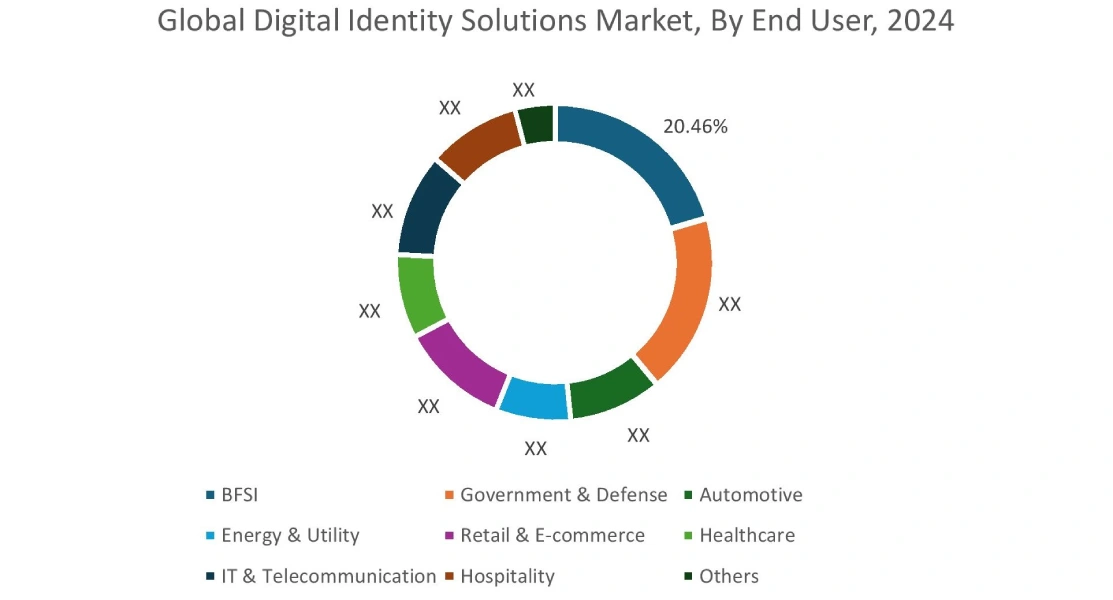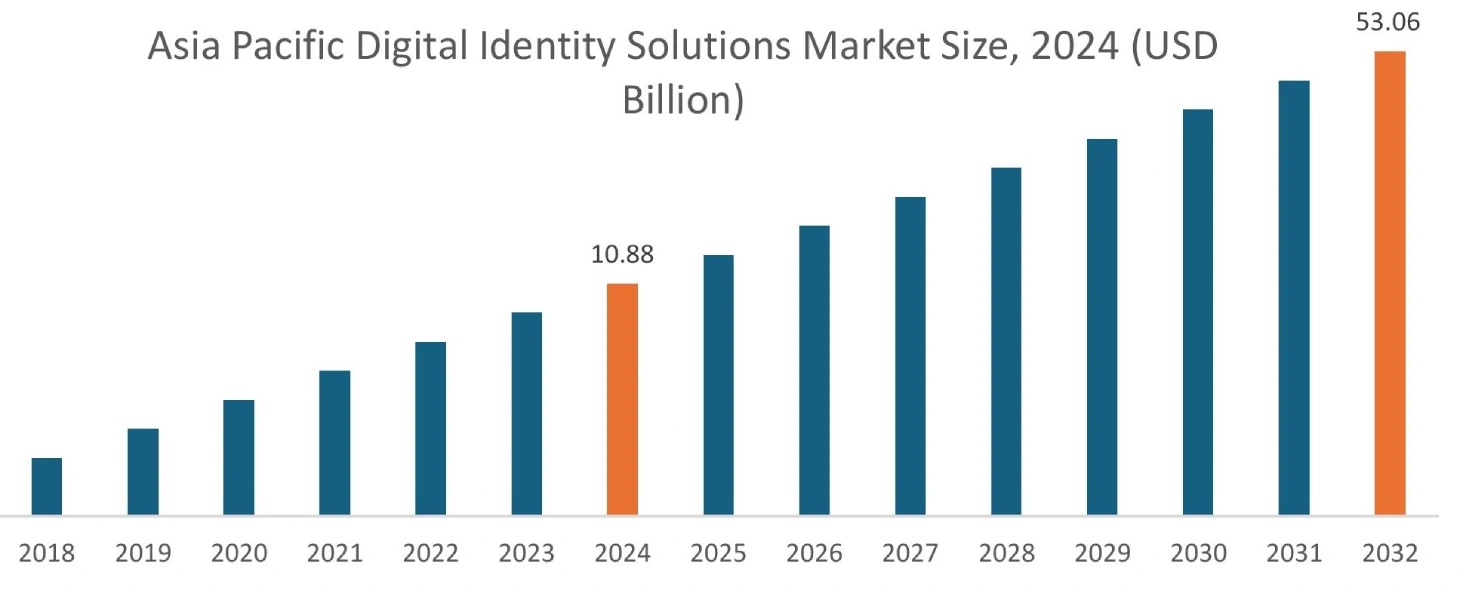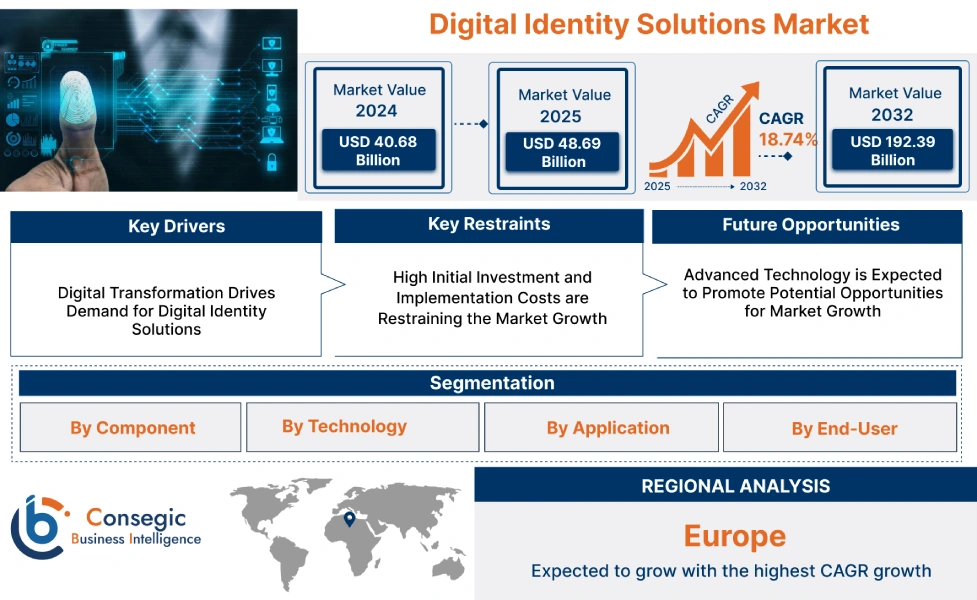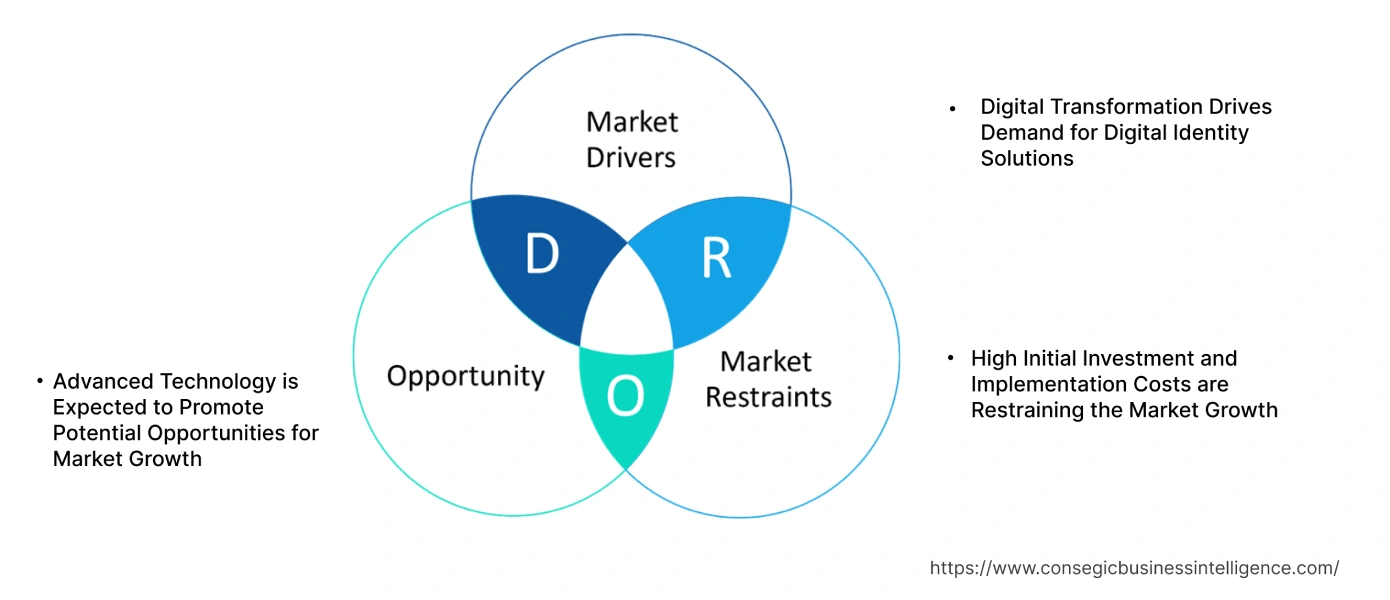Digital Identity Solutions Market Size:
Digital Identity Solutions Market size is estimated to reach over USD 192.39 Billion by 2032 from a value of USD 40.68 Billion in 2024 and is projected to grow by USD 48.69 Billion in 2025, growing at a CAGR of 18.74% from 2025 to 2032
Digital Identity Solutions Market Scope & Overview:
Digital identity solutions refer to a technology which creates, manages, and verifies digital identities for users, devices, and systems. Also, the key advantages of utilizing the solution include enhanced cybersecurity, promoting trust, improved user experience, and increased operational efficiency, among others. Moreover, the rising adoption zero zero-trust security is driving the Digital Identity Solutions Market growth. Further, digitalization as well as rising cybersecurity threats are propelling the Digital Identity Solutions Market demand. Furthermore, stringent regulatory compliance and mandates are driving the digital identity solutions industry.
Key Drivers:
Digital Transformation Drives Demand for Digital Identity Solutions
The rapid digitalization in businesses and governments, among others, for applications such as digital platforms for secure and efficient identity verification and management, is driving the Digital Identity Solutions Market demand. Additionally, the rising demand for online payment in industry such as banking, healthcare, e-commerce, and others is paving the way for the Digital Identity Solutions Market growth. Further, the growing cybersecurity concerns, as well as data privacy and compliance regulations, are fueling the market adoption.
- For instance, in April 2025, SITA partnered with NEC Corporation to integrate real-time digital identity verification and other solutions with SITA’s digital travel ecosystem for improving safety and security as well as promoting digitalization at airports.
Therefore, the rapid digitalization is driving the adoption of security solutions, in turn proliferating the growth of the market.
Key Restraints:
High Initial Investment and Implementation Costs are Restraining the Market Growth
The deployment of the solution requires significant upfront investment for hardware, software, and integration services, which in turn hinders the Digital Identity Solutions Market expansion. Additionally, ongoing maintenance, updates, and potential upgrades incur huge costs, creating a barrier for small and medium enterprises to adopt solutions, in turn restraining the market development. Further, the high cost and delayed implementation or adoption of the solution hinder the market evolution.
Therefore, the high costs of deployment and integration are restraining the Digital Identity Solutions Market expansion.
Future Opportunities :
Advanced Technology is Expected to Promote Potential Opportunities for Market Growth
The rising integration of advanced technology such as artificial intelligence (AI), machine learning (ML) and blockchain technology, among others, into the system is expected to significantly boost the Digital Identity Solutions Market opportunities. Additionally, the advanced technology helps to enhance security and efficiency, boost user experience and streamline processes, among others is propelling the market development. Further, Blockchain technology offers a decentralized and tamper-proof platform for digital identity, increasing security and transparency.
- For instance, in May 2025, Sumsub launched a digital identity solutions based on the Solana blockchain, which carries their credentials across decentralized applications. The system provides real-time identity verification as well as cuts down on the repeated document submission process and shortens onboarding times.
Hence, the rising adoption of advanced technology is anticipated to increase the utilization of the solution in turn promoting prospects for Digital Identity Solutions Market opportunities during the forecast period.
Digital Identity Solutions Market Segmental Analysis :
By Component:
Based on the component, the market is segmented into hardware, software, and services.
Trends in the Component:
- The rising adoption of decentralized identity systems is driving the Digital Identity Solutions Market trends.
- The integration of software solutions with IoT devices is propelling the digital identity solutions market trends.
Hardware accounted for the largest revenue share in the year 2024.
- Hardware component comprises of biometric scanners, smart cards and tokens, and others, which collectively boosts the market growth.
- Additionally, the increasing need for robust security in a digital world, as well as growing digital services, is driving the need for hardware components, which in turn is fueling the digital identity solutions market share.
- Further, the need for seamless and secure digital identity is driving the demand for hardware components, which in turn is fueling the Digital Identity Solutions Market share.
- For instance, in July 2025, IDnow partnered with Keyless to integrate a robust range of identity verification and digital signature solutions with biometric multi-factor authentication technology due to the need for seamless and secure digital identity.
- Thus, according to the Digital Identity Solutions Market analysis, the need for seamless and secure digital identity is driving the adoption of hardware components, which in turn is driving the market growth.
Services segment is anticipated to register the fastest CAGR during the forecast period.
- The services component helps organizations manage the lifecycle of digital identities, control access to resources, and maintain the integrity of data is driving the need for the services component.
- Additionally, the proliferation of online banking and e-commerce to healthcare portals and government services is driving the need for the services segment, which in turn boosts the Digital Identity Solutions Market size.
- Further, the key factors driving the demand for services include the increasing adoption of digital services, rising cybersecurity threats, and the need for regulatory compliance.
- Therefore, as per the market analysis, the rapid digitalization and aforementioned factors are anticipated to boost the market during the forecast period.
By Technology:
Based on the technology, the market is bifurcated into biometric and non-biometric.
Trends in the Technology:
- The trend towards increased adoption of digital wallets is driving the non-biometric technology, which in turn is fueling the market progress.
- The rising adoption of facial and fingerprint recognition technology due to their accuracy and convenience is driving the demand for biometric technology.
Non-biometric accounted for the largest revenue share in the year 2024.
- The non-biometric technology comprises of passwords, pins, one-time passwords (OTPS), and security questions.
- Additionally, the key advantages of adopting non-biometric technology include enhanced security, improved user experience, and increased efficiency, which in turn boosts the digital identity solutions market size.
- Further, the extension of online shopping and digital services is paving the way for the adoption of non-biometric technology for secure and efficient identity verification processes.
- Thus, according to the Digital Identity Solutions Market analysis, the extension of online shopping and digital services is driving the adoption of non-biometric solutions.
Biometric is anticipated to register the fastest CAGR during the forecast period.
- Biometric technology includes fingerprint recognition, facial recognition, iris recognition, voice recognition, and palm/hand recognition.
- Additionally, the stringent data protection regulations as well as the need for user-friendly authentication methods are driving the biometric technology segment.
- Further, the proliferation of cyberattacks, as well as the rising need for stronger authentication and verification methods, is driving the adoption of biometric technology.
- Furthermore, the integration of AI and machine learning and the adoption of cloud-based solutions due to the need for secure remote access and authentication are driving the market progress.
- For instance, in May 2025, Facephi Biometría launched AI-powered biometric identity verification solutions on AWS Marketplace designed for all organizations size to strengthen digital security.
- Therefore, as per the market analysis, the proliferation of cyberattacks as well as the rising need for stronger authentication and verification methods are anticipated to boost the market during the forecast period.
By Application:
Based on the application, the market is segmented into identity proofing, authentication, authorization, lifecycle management, and others.
Trends in the Application:
- The trend towards a shift towards passwordless authentication and multi-factor authentication is driving the market progress.
- The trend towards the rise of zero-trust architecture is paving the way for the adoption of lifecycle management is driving the market progress.
Authentication accounted for the largest revenue share in the year 2024.
- The authentication is a process of verifying the identity of a user before providing access to data or a system which in turn is driving the adoption in BFSI and other industries.
- Additionally, the growing need for secure access to digital platforms due to increased cyber-attacks is propelling the market adoption of authentication applications.
- Further, the rise of digital banking and e-commerce expansion is driving the need for authentication.
- For instance, in June 2025, Zumigo collaborated with GDS Link to strengthen front-end fraud detection as well as maintain a seamless onboarding experience. The collaboration aims to strengthen their authentication workflows by preventing identity fraud, governing risk, and ensuring reliability.
- Thus, as per the market analysis, the rise of digital banking and e-commerce development is driving the market adoption in authentication applications.
Identity Proofing is anticipated to register the fastest CAGR during the forecast period.
- Identity proofing is the process of verifying a person's claimed identity to prevent fraud and ensure secure access.
- Additionally, the identity proofing solutions use various methods such as document verification, biometric authentication, and liveness detection to establish trust and prevent fraud.
- Further, the rising frequency of cyberattacks is driving the market adoption for identity proofing applications.
- Therefore, as per the market analysis, the rising frequency of cyberattacks is anticipated to boost the market during the forecast period.
By End User:
Based on the end user, the market is segmented into BFSI, government & defence, automotive, energy & utility, retail & e-commerce, healthcare, IT & telecommunication, hospitality, and others.
Trends in the End User:
- The trend towards rising adoption of eKYC platforms and AI-powered verification is driving the market adoption in the BFSI sector.
- The increasing focus on securing patient identification during virtual consultations and remote monitoring is driving the market adoption in the healthcare sector.
BFSI accounted for the largest revenue share of 20.46% in the year 2024.
- The rise of cyber threats, fraud, and the need for enhanced customer experience is propelling the market adoption in the BFSI sector.
- Additionally, the rising adoption of blockchain technology due to a secure and transparent way to manage digital identities and user data is driving the adoption in the BFSI sector.
- Further, the key factors driving the market adoption in the BFSI sector include the adoption of biometric verification, AI-powered fraud detection, blockchain-based solutions, and digital identity wallets.
- For instance, in July 2024, NatWest, a UK-based bank, integrated OneID with bank-verified digital identity to deliver seamless, simplified, and secure customer experiences.
- Thus, the rise of cyber threats, fraud, and the need for enhanced customer is driving the market progress.
Government & Defence is anticipated to register the fastest CAGR during the forecast period.
- The rising defence budget as well as initiatives to digitalize tax filing, healthcare, and social security, among others, are propelling the market adoption.
- Additionally, the biometric technologies such as facial recognition and fingerprint scanning are being incorporated into the government & defence sector to enhance security and accuracy.
- Further, the increased digitalization in the government and defence sector to adopt more secure and user-friendly identity systems is driving the market progress.
- Therefore, the increased digitalization as well as the rising defence budget are anticipated to boost the market during the forecast period.

Regional Analysis:
The regions covered are North America, Europe, Asia Pacific, Middle East and Africa, and Latin America.

Asia Pacific region was valued at USD 10.88 Billion in 2024. Moreover, it is projected to grow by USD 13.05 Billion in 2025 and reach over USD 53.06 Billion by 2032. Out of this, China accounted for the maximum revenue share of 31.85%. The market progress is mainly driven by rising initiatives by government to promote safety and security in online payments and other. Furthermore, factors including the increasing digital transformation, the rise of e-commerce and online services and others are projected to drive the market progress in the Asia Pacific region during the forecast period.
- For instance, in April 2025, Nametag launched Adaptive e-ID Verification, designed to allow users to verify identity by utilizing e-ID instead of a physical identity document. The solution is utilized in India and is integrated with Aadhaar to offer a seamless, document-free identity verification experience for users.

North America is estimated to reach over USD 63.22 Billion by 2032 from a value of USD 13.33 Billion in 2024 and is projected to grow by USD 15.96 Billion in 2025. The North American region's increasing cybersecurity threats offer lucrative growth prospects for the market. Additionally, the rise of digital services as well as advancements in technologies such as biometrics and AI are driving the market progress.
- For instance, in May 2024, Resecurity based in the USA launched a digital identity protection solution aiming to empower individuals and organizations to safeguard their identity due to rising cyberattacks.
The regional analysis depicts that the growing adoption of digital identity wallets is driving the market in Europe. Additionally, the key factor driving the market is the increasing digitalization, as well as government initiatives promoting e-governance and public service delivery are propelling the market adoption in the Middle East and African region. Further, the need for secure online transactions and government initiatives for digital transformation is paving the way for the progress of the market in the Latin American region.
Top Key Players and Market Share Insights:
The global Digital Identity Solutions Market is highly competitive with major players providing digital identity solutions to the national and international markets. Key players are adopting several strategies in research and development (R&D), product innovation, and end user launches to hold a strong position in the digital identity solutions industry. Key players in the Digital Identity Solutions Market include-
- NEC Corporation (Japan)
- CrowdStrike (USA)
- ForgeRock, Inc. (USA)
- Telus (Canada)
- GB Group (UK)
- IBM (USA)
- Samsung SDS (South Korea)
- Thales (France)
- SailPoint Technologies, Inc. (USA)
- Daon, Inc. (USA)
Recent Industry Developments :
Product launches
- In October 2024, MATTR launched personal credential capabilities, aiming to enable seamless verification across both face-to-face and digital communication. Also, the capabilities are associated to the ISO 18013.
Digital Identity Solutions Market Report Insights :
| Report Attributes | Report Details |
| Study Timeline | 2019-2032 |
| Market Size in 2032 | USD 192.39 Billion |
| CAGR (2025-2032) | 18.74% |
| By Component |
|
| By Technology |
|
| By Application |
|
| By End User |
|
| By Region |
|
| Key Players |
|
| North America | U.S. Canada Mexico |
| Europe | U.K. Germany France Spain Italy Russia Benelux Rest of Europe |
| APAC | China South Korea Japan India Australia ASEAN Rest of Asia-Pacific |
| Middle East and Africa | GCC Turkey South Africa Rest of MEA |
| LATAM | Brazil Argentina Chile Rest of LATAM |
| Report Coverage |
|
Key Questions Answered in the Report
How big is the digital identity solutions market? +
The digital identity solutions market size is estimated to reach over USD 192.39 Billion by 2032 from a value of USD 40.68 Billion in 2024 and is projected to grow by USD 48.69 Billion in 2025, growing at a CAGR of 18.74% from 2025 to 2032.
Which segmentation details are covered in the digital identity solutions report? +
The digital identity solutions report includes specific segmentation details for component, technology, application, end user, and regions.
Which is the fastest segment anticipated to impact the market growth? +
In the digital identity solutions market, the government & defence sector is the fastest-growing segment during the forecast period due to the increased digitalization as well as the rising defence budget.
Who are the major players in the digital identity solutions market? +
The key participants in the digital identity solutions market are NEC Corporation (Japan), CrowdStrike (USA), IBM (USA), Samsung SDS (South Korea), Thales (France), SailPoint Technologies, Inc. (USA), Daon, Inc. (USA), ForgeRock, Inc. (USA), Telus (Canada), GB Group (UK), and others.
What are the key trends in the digital identity solutions market? +
The digital identity solutions market is being shaped by several key trends including a shift towards passwordless authentication and multi-factor authentication, as well as the rising adoption of eKYC platforms and others.


